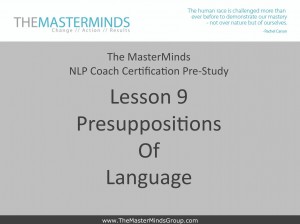Yay!
We’re now entering the section on language. It’s a BIG part of what NLP is all about (the 2nd word in our name is “Linguistic”!). You’ll be learning about language throughout the NLP Practitioner course, but also the NLP Master Practitioner course, and at all levels of Hypnosis certification as well!
We’re starting with the PRESUPPOSITIONS of LANGUAGE (not to be confused with the NLP Presuppositions!)
There are several videos/MP3 for you to watch and listen to:
1. Video: Bird-eye view of Presuppositions of Language.

2. An MP3 where I give you concrete examples.
3. An MP3 with exercise (well, 2 exercises to be exact). You’ll need to download and print out a pdf document first, click here to get the PDF and print it out. When you’re done printing, click here to get the MP3.
Have fun!
Oh! By the way, I meant to tell you in the last MP3: what I did when I first learned this stuff, was to buy a small notebook, and whenever I heard & recognised a Presupposition of Language, I would make a note of it. It really helps to get familiar with them. So there is an assignment for you.
ASSIGNMENT: For a whole week (at least), record all the interesting presuppositions of language that you hear or read (people you meet, newspapers, videos, movies etc…). Aim to get 3-5 examples for each category (note in what context you heard them). Email me the assignment.
You’ll also need the notebook for some of the stuff we’ll learn about next in this language section, so it may be a worthwhile investment! 😉
Hi Helene – when I did the first exercise here I got number 4 completely wrong (except 4D). I don’t think I understand the statement itself, never mind the answers! Could you explain a bit more please?
Marina
Hi Marina,
Good question. The section on Presuppositions of Language is meant to train you to listen to the hidden meaning in people’s speech. People do not choose the words they choose randomly; there is a certain intention behind them, even if this intention is not always conscious. So, as coaches or NLP Practitioners, we want to be crystal clear as to what the language used by the client really means. It is important to understand the Presuppositions of Language before you go onto Milton model.
In the first exercise, sentences 1 to 5 are actual sentences from clients taken from real coaching sessions. The purpose of the exercise is to perceive the difference between the meaning of the words in a sentence (Presupposition) and the meaning we create behind them (Mind Read).
The hint is: when the word is in the sentence, it is a presupposition. When the word is NOT in the sentence, it is a mind read.
Example, in the first sentence (which is a real life example by the way!) the words ‘wife’ and ‘beating’ are in the client’s sentence, so from the language used by the client, we can safely presuppose that he has a wife, and that he beats his wife; the word ‘love’ however is not, so to say that he loves his wife is a mind read on the part of the coach.
Let me know if this answers your question.